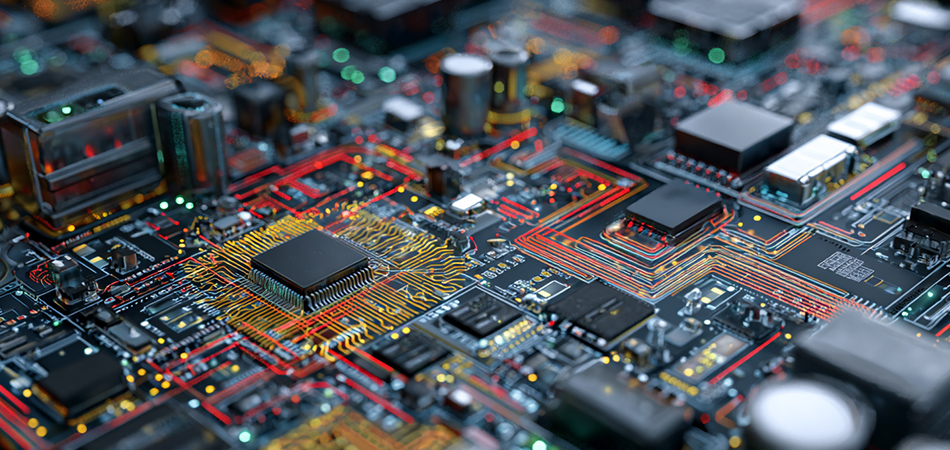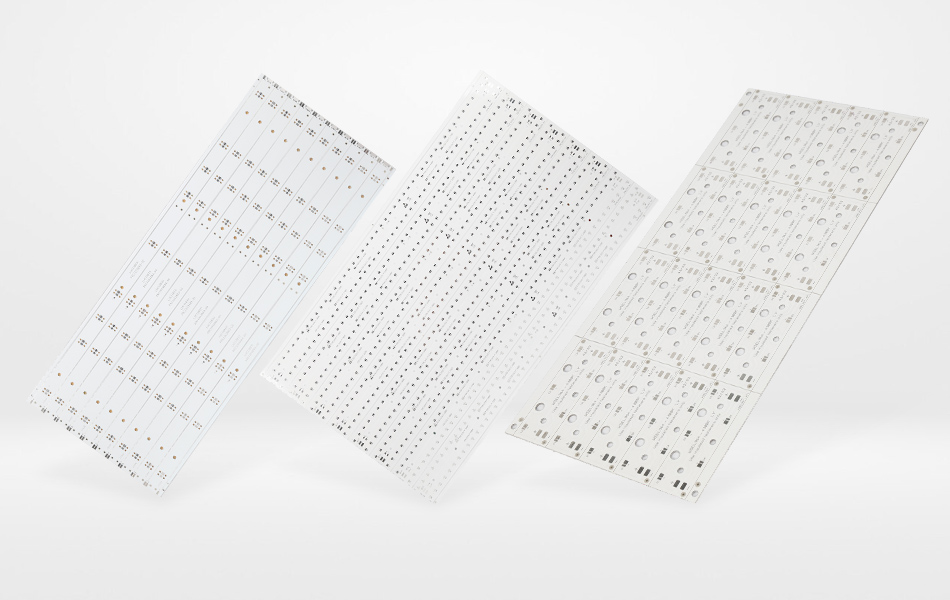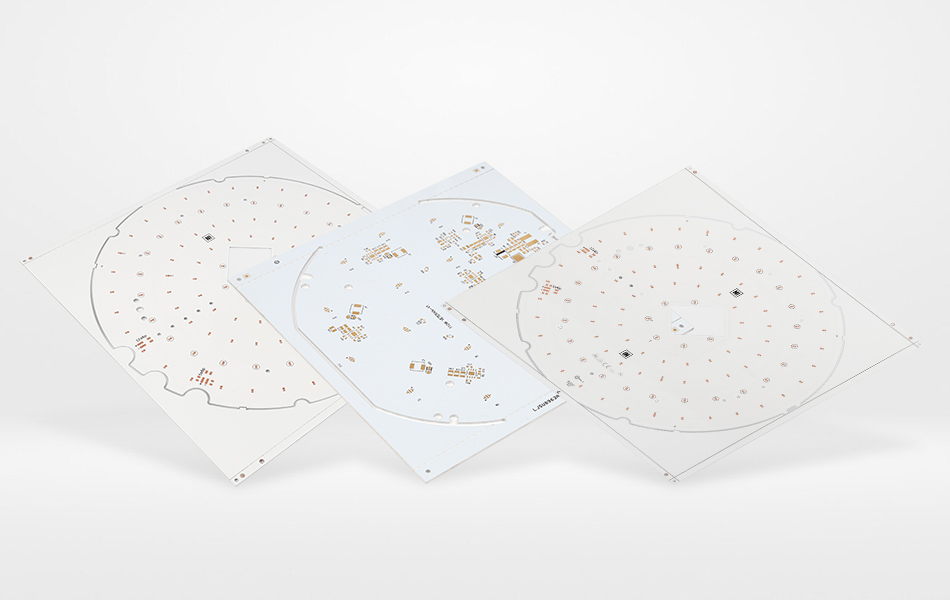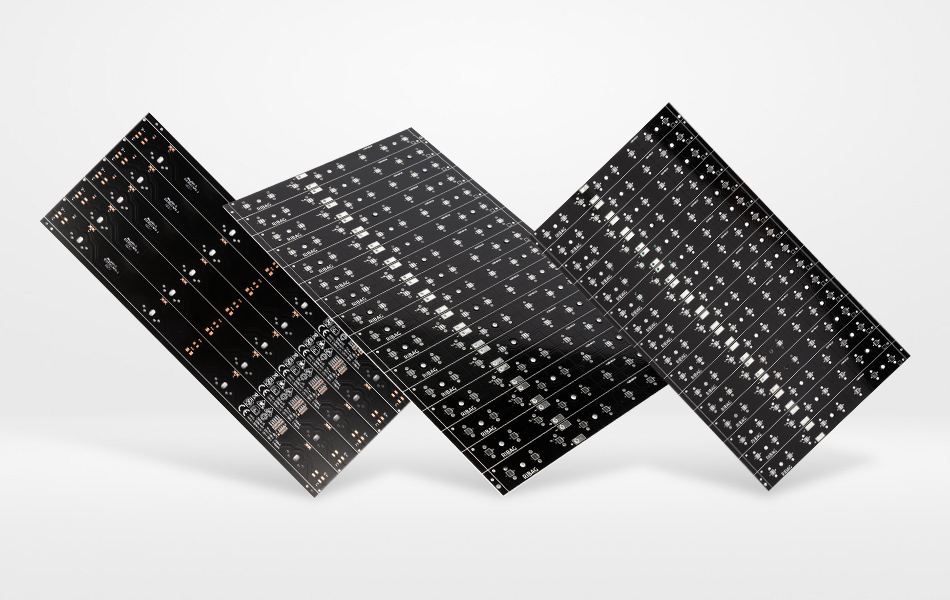-
- PCB TYPE
- PRINTED CIRCUIT BOARD PROTOTYPE ALUMINUM PRINTED CIRCUIT BOARD R&F PCB FPC HIGH FREQUENCY PCB HIGH-TG PCB HEAVY COPPER PCB HDI PCB PCB FOR LIGHTING METAL CORE PCB
time:Jun 26. 2025, 10:40:46
In the rapidly evolving landscape of electronics, Aluminum Printed Circuit Boards (PCBs) have emerged as a revolutionary force, transforming the way electronic devices are designed and manufactured. As the demand for smaller, more powerful, and energy - efficient electronics surges, traditional PCB materials often struggle to meet the stringent requirements of modern applications. Aluminum PCBs, with their unique combination of excellent thermal management capabilities, mechanical strength, and electrical performance, have filled this gap, becoming an indispensable component in a wide range of industries.
This article aims to provide a comprehensive and in - depth exploration of aluminum PCBs. We will start by delving into the fundamental structure and components that constitute these boards, understanding how each element contributes to their overall functionality. Then, we will examine the intricate manufacturing processes involved, highlighting the techniques and technologies that enable the production of high - quality aluminum PCBs. Additionally, we will analyze the numerous advantages they offer over traditional PCBs, explore their diverse applications across various sectors, and discuss the future trends and challenges that lie ahead.
Structure and Components of Aluminum PCBs
Aluminum Substrate
At the core of an aluminum PCB lies the aluminum substrate, which serves as the foundation of the board. Aluminum is chosen for its remarkable thermal conductivity, far surpassing that of conventional PCB materials. This high thermal conductivity allows the substrate to act as an efficient heat sink, rapidly dissipating heat generated by heat - producing components mounted on the PCB.
The aluminum substrate is typically fabricated from an aluminum alloy, carefully selected based on the specific requirements of the application. Different alloys possess varying properties, such as strength, corrosion resistance, and thermal conductivity. For instance, in applications where high - power components are in use, alloys with enhanced thermal conductivity are preferred to ensure effective heat dissipation and prevent overheating. The thickness of the substrate can also be adjusted according to the needs of the design, striking a balance between thermal performance, mechanical stability, and cost.
Dielectric Layer
Sandwiched between the aluminum substrate and the copper traces is the dielectric layer, a crucial component that performs two essential functions: electrical insulation and thermal conduction. From an electrical perspective, the dielectric layer acts as a barrier, preventing electrical short - circuits between the conductive copper traces and the aluminum substrate.
To ensure reliable electrical insulation, the dielectric layer is made from materials with high dielectric strength. At the same time, it must also possess good thermal conductivity to facilitate the transfer of heat from the components through the copper traces and into the aluminum substrate. Modern dielectric materials often incorporate thermally conductive fillers, enhancing their ability to conduct heat while maintaining excellent electrical insulation properties. The thickness of the dielectric layer is precisely controlled, as it directly impacts both the electrical and thermal performance of the PCB.
Copper Traces
The copper traces on an aluminum PCB are responsible for carrying the electrical current to the various components, serving as the lifeblood of the electronic circuit. Copper is the material of choice due to its high electrical conductivity, which minimizes resistance and power losses within the circuit. High - purity copper is typically used to ensure optimal electrical performance.
The layout of the copper traces is meticulously designed using computer - aided design (CAD) software, taking into account factors such as the electrical requirements of the components, signal integrity, and electromagnetic interference (EMI) prevention. The width and thickness of the traces are carefully determined based on the amount of current they need to carry, with wider and thicker traces capable of handling higher currents. In addition, proper separation of power and signal traces is essential to prevent EMI and ensure the stable operation of the electronic device.

Manufacturing Processes of Aluminum PCBs
Material Preparation
The manufacturing process of aluminum PCBs commences with the meticulous preparation of materials. High - quality aluminum sheets are sourced, and their surface is treated to improve adhesion with the dielectric layer. The dielectric material, often in the form of a pre - impregnated film or a liquid resin, is also prepared, with additives and fillers incorporated to achieve the desired electrical and thermal properties.
Meanwhile, high - purity copper foils are selected for the traces and undergo surface treatment to enhance their bonding with the dielectric layer. All materials are carefully inspected to ensure they meet the required quality standards before proceeding to the next stage of production.
Lamination
Lamination is a critical step in the manufacturing process, where the aluminum substrate, dielectric layer, and copper foils are bonded together to form a single, cohesive structure. This is typically achieved through the application of heat and pressure in a laminator.
During lamination, the heat activates the thermosetting resin in the dielectric layer, causing it to flow and form a strong bond with the aluminum substrate and copper foils. The pressure ensures that the layers are in intimate contact, eliminating any air gaps or voids that could compromise the performance of the PCB. Precise control of the lamination temperature, pressure, and time is essential to achieve a high - quality bond and ensure the integrity of the PCB.
Drilling and Plating
After lamination, holes are drilled into the PCB for various purposes, such as component mounting, via connections, and electrical pathways. High - precision drilling machines, equipped with advanced control systems, are used to ensure accurate hole placement and dimensions. Specialized drill bits, designed to cut through the aluminum substrate and dielectric layer, are employed to minimize burr formation and ensure clean holes.
Following drilling, the holes are electroplated with copper to create electrical connections between the layers of the PCB. Electroplating involves immersing the PCB in an electrolyte solution containing copper ions and applying an electric current. The copper ions are then deposited on the surface of the holes and the copper traces, forming a continuous layer of copper that provides reliable electrical conductivity.
Circuit Patterning
Circuit patterning is the process of creating the intricate electrical circuits on the copper layers of the PCB. Photolithography is a commonly used technique for this purpose. A photosensitive resist is applied to the copper surface, which is then exposed to ultraviolet (UV) light through a patterned mask. The areas of the resist exposed to UV light undergo a chemical change, making them soluble in a developer solution.
After development, the exposed copper areas are etched away using an etching solution, leaving behind the desired copper traces. This process requires high precision to ensure accurate trace widths, clearances, and the absence of shorts or open circuits. Advanced photolithography equipment and techniques are utilized to achieve the fine - pitch patterns required for modern electronics.
Surface - Mount Assembly
The final stage of the manufacturing process is surface - mount assembly, where the electronic components are mounted onto the PCB. Automated pick - and - place machines are used to precisely position the components on the designated pads on the PCB. The components are then soldered to the PCB using reflow soldering or wave soldering techniques.
Reflow soldering is a widely used method for surface - mount assembly, especially for complex PCBs with a large number of components. In this process, the PCB with the placed components is passed through a reflow oven, where the solder paste melts and bonds the components to the PCB. Proper control of the temperature profile in the reflow oven is crucial to ensure good solder joints and reliable electrical connections.

Advantages of Aluminum PCBs
Superior Heat Dissipation
One of the most significant advantages of aluminum PCBs is their exceptional heat - dissipation capabilities. The high thermal conductivity of the aluminum substrate enables rapid heat transfer away from heat - generating components, effectively preventing overheating. This is particularly important in applications where high - power components, such as LEDs, power transistors, and integrated circuits, are used.
By maintaining the components at a lower operating temperature, aluminum PCBs can significantly extend the lifespan of the components, reduce the risk of thermal stress - induced failures, and improve the overall reliability of the electronic device. In some cases, the enhanced heat dissipation of aluminum PCBs can even eliminate the need for additional cooling mechanisms, such as fans or heat sinks, resulting in a more compact and cost - effective design.
Compact and Lightweight Design
Thanks to the combination of the thin aluminum substrate and surface - mount technology, aluminum PCBs offer a highly compact and lightweight design. The thinness of the aluminum substrate allows for a more streamlined profile, while the use of surface - mount components reduces the overall size and weight of the PCB assembly.
This compact and lightweight design is highly desirable in a variety of applications, especially in portable electronics, aerospace, and automotive industries, where space and weight are at a premium. It enables the creation of smaller, more portable devices without sacrificing performance, and also helps to reduce fuel consumption and improve the efficiency of vehicles and aircraft.
Excellent Mechanical Strength
Aluminum PCBs possess excellent mechanical strength, making them more resistant to physical damage compared to traditional PCBs. The aluminum substrate provides a rigid and stable foundation for the components, protecting them from mechanical stress, vibration, and shock.
This enhanced mechanical strength is particularly important in applications where the PCB is subjected to harsh environmental conditions or frequent handling, such as in industrial control systems, military equipment, and consumer electronics. It ensures the long - term reliability and durability of the electronic device, reducing the risk of component failure due to mechanical damage.
Energy Efficiency
Aluminum PCBs contribute to energy efficiency in electronic devices by enabling components to operate at their optimal efficiency. By effectively dissipating heat, they prevent components from overheating, which can lead to increased power consumption and reduced efficiency.
In addition, the long lifespan of components in aluminum - PCB - based systems means that there is less need for frequent replacements, resulting in further energy savings. This makes aluminum PCBs an environmentally friendly choice, aligning with the growing trend towards sustainable electronics manufacturing.

Applications of Aluminum PCBs
Lighting Industry
The lighting industry has been one of the earliest and most enthusiastic adopters of aluminum PCBs. In LED lighting applications, where efficient heat dissipation is crucial for the performance and lifespan of the LEDs, aluminum PCBs have become the standard choice.
In architectural lighting, aluminum - PCB - based LED modules are used to create stunning visual effects, highlight architectural features, and provide ambient illumination. In automotive lighting, they are employed in headlights, taillights, and interior lighting, offering improved energy efficiency, longer lifespan, and better lighting performance. The ability to control the color, intensity, and direction of the light with aluminum PCBs has also opened up new possibilities for creative lighting design.
Automotive Electronics
The automotive industry has witnessed a significant increase in the use of aluminum PCBs in recent years. In modern vehicles, electronic systems play a crucial role in various functions, including engine control, safety, entertainment, and communication. Aluminum PCBs are used in engine control units (ECUs), infotainment systems, advanced driver - assistance systems (ADAS), and lighting systems.
The harsh operating environment of vehicles, characterized by high temperatures, vibrations, and electrical noise, demands components with excellent thermal management, mechanical strength, and reliability. Aluminum PCBs meet these requirements, ensuring the stable and reliable operation of automotive electronics. They also contribute to the miniaturization and weight reduction of automotive electronic systems, improving fuel efficiency and vehicle performance.
Aerospace and Defense
In the aerospace and defense sectors, where reliability, performance, and safety are of utmost importance, aluminum PCBs have found widespread applications. In avionics systems, which are responsible for navigation, communication, and control in aircraft, aluminum PCBs are used to ensure the reliable operation of critical components in the face of extreme environmental conditions, such as high altitudes, rapid temperature changes, and intense vibrations.
In defense applications, such as missile guidance systems, radar systems, and military communication equipment, aluminum PCBs provide the necessary thermal management and mechanical strength to withstand the rigors of combat and harsh field environments. Their lightweight design also helps to reduce the overall weight of aerospace and defense equipment, improving performance and mobility.
Consumer Electronics
Consumer electronics, including smartphones, tablets, laptops, smartwatches, and home appliances, have also benefited from the use of aluminum PCBs. In these devices, where space is limited and heat management is a challenge, aluminum PCBs offer a compact and efficient solution.
They are used in the main boards, battery charging circuits, display backlighting, and power management systems of consumer electronics, ensuring reliable performance, long battery life, and a sleek design. The ability of aluminum PCBs to dissipate heat effectively also helps to prevent overheating, which can cause performance degradation and shorten the lifespan of the device.

Future Trends and Challenges
Miniaturization and Higher Integration
As the electronics industry continues to pursue miniaturization and higher levels of integration, the demand for smaller and more densely packed aluminum PCBs will increase. This will require the development of new manufacturing techniques and technologies to achieve finer pitches, smaller hole sizes, and more complex circuit patterns.
Advanced micro - machining, nanotechnology, and 3D - printing technologies are likely to play a crucial role in the future of aluminum PCB manufacturing, enabling the production of PCBs with unprecedented levels of precision and complexity. However, these advancements also bring challenges, such as increased manufacturing costs, yield issues, and the need for more sophisticated quality control measures.
Integration of New Materials and Technologies
The integration of new materials, such as graphene, carbon nanotubes, and advanced composites, into aluminum PCBs is expected to open up new possibilities for improving their performance. These materials offer unique properties, such as exceptional thermal conductivity, electrical conductivity, and mechanical strength, which can further enhance the capabilities of aluminum PCBs.
At the same time, emerging technologies, such as the Internet of Things (IoT), artificial intelligence (AI), and 5G communication, will drive the development of new applications for aluminum PCBs. These applications will require PCBs with higher performance, greater reliability, and faster data transfer speeds, posing new challenges for the design and manufacturing of aluminum PCBs.
Environmental Sustainability
With the growing awareness of environmental issues, the electronics manufacturing industry is under increasing pressure to adopt more sustainable practices. This includes the development of environmentally friendly materials, manufacturing processes, and recycling methods for aluminum PCBs.
Reducing the use of hazardous chemicals, minimizing waste generation, and improving the recyclability of aluminum PCBs will be important considerations in the future. The industry will need to collaborate with researchers, policymakers, and environmental organizations to develop innovative solutions that balance the need for technological advancement with environmental protection.

Conclusion
Aluminum PCBs have emerged as a game - changer in the electronics industry, offering a wide range of advantages over traditional PCBs. Their exceptional heat - dissipation capabilities, compact and lightweight design, excellent mechanical strength, and energy efficiency have made them an essential component in a diverse range of applications across various industries.
As the electronics industry continues to evolve, aluminum PCBs will face new challenges and opportunities. The pursuit of miniaturization, the integration of new materials and technologies, and the focus on environmental sustainability will drive the development of new and improved aluminum PCB solutions. By staying at the forefront of innovation and addressing these challenges head - on, the industry can ensure that aluminum PCBs continue to play a vital role in shaping the future of electronics.

Got project ready to assembly? Contact us: info@apollopcb.com



We're not around but we still want to hear from you! Leave us a note:

Leave Message to APOLLOPCB
